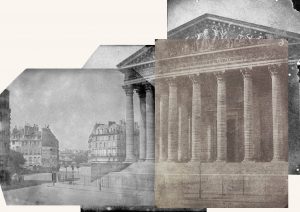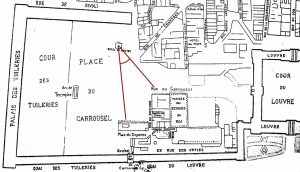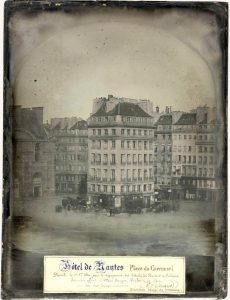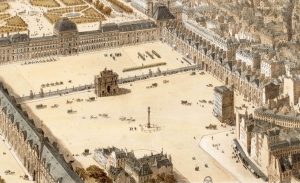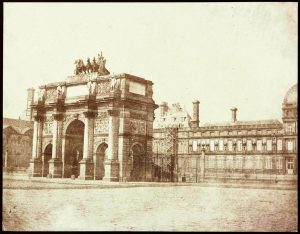
Our Parisian Research Affiliate Édouard de Saint-Ours has made two contributions so far of some of the fascinating results of his close study of Talbot’s photographs of his home town. Today he more closely examines the role of the Marquis de Bassano. We have touched on the mysterious Marquis before.
But first some exciting project news about a fundamental change that you as a reader will probably never notice but one that is making life easier and more productive for our intrepid Brian Liddy and Jaanika Vider. The ‘back end’ of the Catalogue Raisonné – where the sausage is made and the part that you never see – was built on software known as Substance-D. I will stop short of giving my opinion of it and I won’t give free reign to Brian and Jaanika to vent. Last week we completed the switch over to Django, an open-source software much more intuitive for them to use and also more future-proof. (I know that you are going to ask, thinking perhaps that it was named after the ‘Animal Liberation Orchestra’ or perhaps a 1960s Spaghetti Western. But according to their website, they are honoring Jean ‘Django’ Reinhardt (1910-1953), a briliant Belgian-born Romani musician and composer known mostly for his mastery of the guitar. Although he toured the US, Django made his reputation in Paris, which leads neatly into our next segment.
Guest Post by Édouard de Saint-Ours
Throughout the second half of 1842 and early 1843, Henry Talbot and Amélina Petit de Billier (1798-1876, Talbot’s family governess and friend, who resided in Paris at the time) corresponded eagerly about a potential agreement for the commercial exploitation of the calotype process in France. She had been advising him on the subject ever since the summer of 1842 , while actively promoting the process among artists and opticians in Paris. In September of that year, Talbot informed her that he wished to sell his patent in France and suggested that a “company of artists” might be interested in purchasing it. In spite of an uneasy relationship with capitalism stemming from his genteel education, he also asked her to draw the attention “of the monied interest” on the calotype process.
At the end of January 1843, Amélina Petit gladly wrote to Talbot that someone had finally expressed interest. Hugues Antoine Joseph Eugène Maret (1806-1889), marquis de Bassano, was a French entrepreneur whose family entertained close relations with Napoleonic aristocracy and the July Monarchy court. Aware of the potentially enormous profits that could be derived from the calotype, Bassano led Talbot to agree to an elaborate industrial scheme. A veritable legion of calotypists would take pictures in every corner of France, and the prints derived from their negatives would be sold to the French bourgeois public. Faced with the necessity of instructing them all, Talbot remarked in a letter to Amélina Petit on 8 February: “But how can so many young artists be instructed at one time? A kind of École Normale de Photographie in Paris would be necessary, and the first attempts of each Calotypist should be made in the environs of the city, until he feels able to proceed with assurance.” At the end of the month, Talbot confirmed that he wished to “spare the artists [the] initial difficulties by coming to play the role of the instructor myself.”
On 2 March, he gave further instructions regarding the calotype school: “…it is highly necessary to have a bright, spacious locality, which, if possible, enjoys a beautiful view, somewhere close to the town…The locality of which I speak would immediately become a training school for the artists associated with the Society, and I believe that ten days of exercises would suffice to train a certain number of Calotypists, who could immediately enter into activity and instruct the others.”
Talbot and Bassano eventually met in London in late March or early April 1843. Amélina Petit’s brother, whose first name has not yet been retrieved, was involved throughout the whole operation and accompanied Bassano to London. With the help of patent agents, it was established that Talbot would cede his French import patent, taken in 1841 for ten years, in exchange for 25% of all gross profits generated by the sale of calotype paper and positive prints in France. The document transferring the patent to Bassano was signed in Paris on 26 June. At that time, Talbot and Nicolaas Henneman (1813-1898), his assistant and servant, had been in France for more than six weeks, providing calotype lessons to Bassano, Petit de Billier and student photographers.
Talbot and Henneman reached Paris on the evening of 19 May. Talbot stayed at the Hôtel de Douvres, at the corner of boulevard des Capucines and rue de la Paix. On 13 June, he left for a short trip to the southwest of Paris. He photographed Orléans, Chambord and Amboise, where he was on 18 June, and probably returned to Paris shortly thereafter. Talbot remained in the French capital until 27 June at least, and was back in England by early July.
But why did Talbot stay in Paris for more than five weeks if “ten days of exercises would suffice to train a certain number of Calotypists”? One reason could be that the calotype workshop may have only started early in June.
On 9 March, Talbot complained to Amélina Petit that no preparations had yet been made regarding the workshop. At the end of April, she informed him that Bassano had identified a suitable studio in the place de la Madeleine. A number of photographs in the catalogue raisonné, apparently all taken from the same vantage point, across the square from the Madeleine church (Schaaf nos. 130, 131, 807-811, 813 & 1458), seem to suggest that some work might have been undertaken in an apartment there. In order to support this, I have put together a composite image from three negatives (digitally inverted) and a print representing the Madeleine.
However beautiful the view, the window from which these photographs were taken faced north, which would have been an issue for calotype printing and could have prompted Talbot to request a better location for the workshop. I could find no other source supporting this hypothesis, but I believe it is an interesting possibility.
The first remaining mention of the workshop actually taking place is found in a letter Talbot wrote to his wife Constance on 7 June 1843: “I have begun to teach the Calotype to the Marquis of Bassano and his friends – Today we took four views of the Tuilleries [sic]. […] The Marquis and his friends have taken for a month an isolated and lofty house that stands in the place du Carousel [sic] fronting the Tuileries – This house will soon be pulled down by the government, as it disfigures the place; in the meantime it has become our workshop.” Out of the few calotype negatives made in Paris that were dated in Talbot’s hand, one of them is inscribed “7 June/43” on the verso, the very day he wrote to Constance about the workshop.
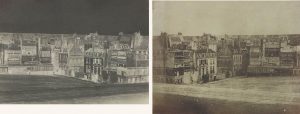
Depicting a corner of the place du Carrousel from a high ground, it was almost certainly taken from the workshop. The negative has manifestly been cropped after the corresponding print was made. The high building emerging from beyond the houses in the background is the Galerie du bord de l’eau, built in 1607-10 to connect the Louvre and the Tuileries. Several other negatives were made of the same view from the same vantage point (Schaaf 1505 & 1506). The houses seen in the pictures can easily be recognised in the following lithograph, depicting the area in 1850.
Part of the Louvre can be seen to the left of the composition, as well as the Galerie du bord de l’eau, to the right. It seems odd today to think that the space between the Louvre and the Tuileries was ever urbanised, but it had been the case for centuries, even though this neighbourhood had been bound for destruction since the 17th century. It took so long that, in his novel La cousine Bette (1838), Honoré de Balzac had called for the annihilation of these “warts from [the Louvre’s] face”. Talbot apparently shared Balzac’s opinion, but the buildings obstructing the area were only effectively destroyed in the early 1850s by Georges Eugène Haussmann, so that the architectural project for the completion of the Louvre could be executed.
A map of the area in the 1840s further identifies the section photographed by Talbot. It also points to the location of the workshop as being, without the shadow of a doubt, in the Hôtel de Nantes, an “isolated and lofty house that stands in the place du Carousel [sic] fronting the Tuileries” (in Talbot’s own words).
The Hôtel de Nantes was photographed in 1850 by an anonymous daguerreotypist, from the top of the Arc de Triomphe du Carrousel. The tip of the unfinished north aisle, commissioned by Napoleon I, can be seen to the left of the composition. The Hôtel de Nantes filled all of Talbot’s initial requirements. Its isolation to the north of a vast square guaranteed that it would be “bright” most of the day. It also probably was “spacious” enough and certainly offered a “beautiful view” of the Tuileries. Furthermore, the whole neighbourhood being bound for destruction, the rent was probably quite low. It is clear why Bassano and Talbot selected this location.
Talbot did certainly not fail to take advantage of the fantastic view, probably the best there was of the Tuileries at the time, and captured it in at least three negatives (Schaaf nos. 1446, 1929 & 1930). These show part of the unfinished north aisle and the north half of the Tuileries.
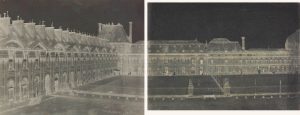
As I have discussed in my previous blog post, Talbot then used his Paris apartment, rented at the Hôtel de Douvres, as an urban observatory allowing him to experiment with panoramic photography. He applied the same idea to the view from the Hôtel de Nantes, as is seen from these negatives.
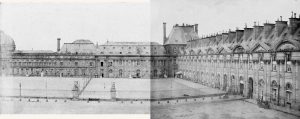
This digital positive version of Talbot’s panorama allows us to better comprehend what he was trying to achieve. The precarious position of the central pavilion of the Tuileries, relegated to the left edge, suggests that this set is possibly a section of a larger panorama. There was certainly much more to see to the left, starting with the Arc de Triomphe du Carrousel, erected in 1807-09 to celebrate Napoleon’s Great army’s victory at Austerlitz. The missing section of this panorama might still emerge in the future, but Talbot also photographed the arch from the ground.
The fact that Talbot made a panorama from the workshop’s windows is very significant. He had then already been experimenting with the idea from his Paris apartment, and I believe that he perceived that such “panoramic joiners”, as Reverend Calvert R. Jones (1804-1877) would later call them, could appeal to the bourgeois public. Even though full daguerreotype panoramas had been made before 1843, Talbot did not go for 360° views. The ones I was able to identify thus far are only ever two- or three-part sets that could potentially be framed or pasted in an album. The commercial potential of such panoramas was highly relevant to Bassano, as they could be an appealing way to capture France’s largest monuments and the country’s landscape. Therefore, the panorama made by Talbot from the Hôtel de Nantes probably served as a demonstration to Bassano and the student calotypists.
As Talbot had imagined some months earlier, the studio rented in the Hôtel de Nantes served as a school of photography, and we must see it as such, however ephemeral it might have been. No account has yet been found listing those who attended the workshop, apart from Bassano himself, Petit de Billier, and an unknown man named Borcier. But it was apparently open to all and could have encouraged the vocation of several calotypists of renown. Hippolyte Bayard (1801-1887), inventor of a direct positive process on paper, and Henri Victor Regnault (1810-1878), who would become another leading French calotypist, are known to have practiced the process earlier with the Rev Calvert R Jones. Both Bayard and Regnault could very well have attended the workshop, if only to improve their skills with the inventor himself. It must also be noted that Jones had sent Talbot a letter of introduction to Bayard in February, and that, on 29 May 1843, Talbot dined with Bayard and Regnault, among other French pioneers of paper photography: Jean-Baptiste Biot (1774-1862), Talbot’s main supporter in the French scientific community, the physicist Hippolyte Fizeau (1819-1896), and the chemist Jean Louis Lassaigne (1800-1859). The connection between Bayard and Talbot is further evidenced by the presence of photographs by Talbot in an album from Bayard’s collection, now owned by the J. Paul Getty Museum.
After Talbot’s departure in late June 1843, Henneman remained in Paris to complete the artists’ formation, until mid-July at least. Bassano and Petit de Billier kept on practicing the calotype in the Carrousel studio and sent some samples to Talbot in late July. In early August, Petit de Billier assured Talbot that he and Bassano were still working on it, although the latter had left Paris . But Bassano soon lost interest and eventually dropped the whole operation, turning to a more profitable mining venture in Algeria. According to Amélina Petit , he was also in debt and failed to pay both the rent for the Carrousel studio and the wages of a hired chemist.
In the end, Talbot’s business venture with Bassano turned out to be a stillborn endeavour. Fortunately, mostly time was lost and Talbot eventually retrieved his import patent in 1845 . But the “calotype school” in the place du Carrousel probably had a more significant influence on the course of paper photography in France than expected, even though much research is still needed regarding its actual impact and who exactly were Talbot’s French student calotypists.
Édouard de Saint-Ours
• Questions or Comments? Please contact digitalsupport@bodleian.ox.ac.uk• The correspondence between Amélina Petit de Billier and Talbot is mostly in French, but for the sake of clarity, I chose to use the English translation for this essay. All the letters on the Correspondence website transcribe both the original language and supply an English translation. • The standard reference on Talbot’s business relations with Bassano is Nancy Keeler’s “Inventors and Entrepreneurs”, History of Photography, v. 26, no. 1, Spring 2002, pp. 26-33. • The precise date of Talbot’s first meeting with Bassano is unknown, but judging from Talbot’s correspondence it took place between 25 March and 5 April 1843. • Three calotype negatives showing the castle at Amboise and the bridge over the Loire are located and dated in Talbot’s hand from 18 May 1843 (Schaaf nos. 2738-2740). • Digital positive from WHFT, View of Paris, including the Eglise de la Madeleine, calotype negative, National Science and Media Museum, Bradford, 1937-2346; Schaaf 1458. • Digital positive from WHFT, Eglise de la Madeleine, Paris, calotype negative, NSMeM, Bradford, 1937-2425; Schaaf 809. • Digital positive from WHFT, Eglise de la Madeleine, Paris, calotype negative, NSMeM, Bradford, 1937-2405; Schaaf 807. • WHFT, Eglise de la Madeleine, Paris, salted paper print, NSMeM, Bradford, 1937-2406; Schaaf 810. • WHFT, Place du Carrousel and roof of the Louvre, Paris, calotype negative, 7 June 1843, NSMeM, Bradford, 1937-2402; Schaaf 2729. • WHFT, Place du Carrousel and roof of the Louvre, Paris, salted paper print, 7 June 1843, NSMeM, Bradford, 1937-2403; Schaaf 2729. • Theodor Josef Hubert Hoffbauer, Place du Carrousel en 1850, lithograph, 1875-82, in Hoffbauer, Paris à travers les âges, 2 vol. (Paris: Firmin-Didot, 2nd ed., 1885), Fig. 55. • About the history of place du Carrousel, see the entry for ‘CARROUSEL (place du)’ in Jacques Hillairet (ed.), Dictionnaire historique des rues de Paris, Vol 1 (Paris: Éditions de Minuit, 2nd edition, 1964), pp. 275-80. • Honoré de Balzac, Cousin Bette (Translated by Katherine Prescott Wormeley, Boston: Roberts Brothers, 1890), p. 69. • The design commissioned by Napoleon III for the Louvre involved the completion of the north aisle started under Napoleon I, the reconstruction of most of the pre-existing structures, and the creation of six courtyards. Louis Visconti, author of the initial design, oversaw the work until his death in 1853. It was then taken over and slightly modified by Hector Lefuel. For more details, see “Le Nouveau Louvre et les Tuileries de Napoléon III (1852-1870)”, in Geneviève Bresc-Bautier, Guillaume Fonkenell and Françoise Mardrus (eds.), Histoire du Louvre, Vol 2 (Paris: Fayard; Louvre editions, 2016), pp. 159-289. • Detail from a map of the Louvre area in the 1840s, Bibliothèque nationale de France, Paris, Est. 5852 2. In Jean-Claude Daufresne, Louvre & Tuileries: Architectures de Papier (Paris: Pierre Mardaga, 1987), p. 230. • Anonymous, Hôtel de Nantes, place du Carrousel, 1er arrondissement, Paris, daguerreotype, 1850, Musée Carnavalet, Paris, PH2862. • Detail from Nicolas Marie Joseph Chapuy (draftsman) and Jules Arnout (lithographer), 1er arrondissement: Vue prise au-dessus du Louvre, lithography, 1840. In Chapuy and Arnout, Paris et ses arrondissements à vol d’oiseau (Paris: S. Avanzo, [c. 1850]), Bibliothèque historique de la Ville de Paris, RESERVE FM 32546. • WHFT, North aisle of the Louvre, Paris, calotype negative, 1843, NSMeM, Bradford, 1937-2420; Schaaf 1930. • WHFT, North half of the Tuileries, Paris, calotype negative, 1843, NSMeM, Bradford, 1937-2354; Schaaf 1929. • Digital positive image obtained from both previous calotype negatives. • WHFT, Arc de Triomphe du Carrousel and the Tuileries, Paris, salted paper print, 1843, NSMeM, Bradford, 1937-2399; Schaaf 54. •About Talbot’s possible connection with Hippolyte Bayard, see Nancy Keeler’s “Souvenirs of the Invention of Photography on Paper: Bayard, Talbot, and the Triumph of Negative-Positive Photography”, in Photography: Discovery and Invention, Papers Delivered at a Symposium held at the J. Paul Getty Museum, January 30, 1989 (Los Angeles: Getty Publications, 1990), pp. 47-62. • The dinner on 29 May 1843 is recorded in one of Talbot’s diaries. WHFT, Travel Diary, May 1843, Fox Talbot Collection, British Library, London, Add MS 889425134. Paul-Louis Roubert underlined the importance of this meeting for the future of the calotype in France in his chapter “Cendrillon ranimée: Émergence de la photographie sur papier en France”, in Sylvie Aubenas and Paul-Louis Roubert (eds.), Primitifs de la photographie: Le calotype en France (1843-1860) [exhibition catalogue] (Paris: Gallimard; Bibliothèque nationale de France, 2010), pp. 35-51.

